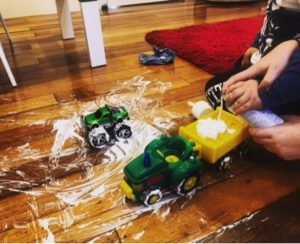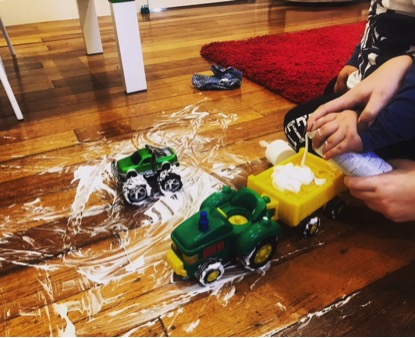Why should we encourage kids in messy play/sensory play?
From the very first day they are born, children are designed to explore the world via all their senses; taste, sight, touch, hearing and smell. That’s why babies and toddlers touch and mouth everything, and why kids make funny noises with their mouths and experiment with how the world sounds with their fingers stuck in their ears. It’s why your child spins in circles until they’re so dizzy, they fall, then get up and do it again.
Sensory exploration is a child’s way of examining, discovering, categorising, and making sense of their world. It’s beneficial for their development to provide them with opportunities for sensory play.
How does it help?
Providing opportunities for children to actively use their senses as they explore their world through ‘sensory play’ is crucial to brain development – it helps to build nerve connections in the brain’s pathways.
This leads to a child’s ability to complete more complex learning tasks and supports cognitive growth, language development, gross motor skills, social interaction and problem solving skills.
Why is it called “sensory play”?
We often talk about the five senses. These are:
Taste – the stimulation that comes when our taste receptors (taste buds) react to chemicals in our mouth.
Touch – the stimulation that comes from touch receptors in our skin that react to pressure, heat/cold, or vibration.

Smell – the stimulation of chemical receptors in the upper airways (nose).
Sight – the stimulation of light receptors in our eyes, which our brains then interpret into visual images.
Hearing – the reception of sound, via mechanics in our inner ear.
Did you know there are two more?
Body awareness (also known as proprioception) – the feedback our brains receive from stretch receptors in our muscles and pressure receptors in our joints, which enable us to gain a sense where our bodies are in space.
Balance – the stimulation of the vestibular system of the inner ear to tell us our body position in relation to gravity.
Sensory play includes any activity that stimulates the senses of our little people: touch, smell, taste, movement, balance, sight and hearing.
How can sensory play help my child?
Sensory activities provide opportunities for exploration and naturally encourage children to use scientific processes while they play, create, investigate and explore. The sensory activities allow children to learn about, and develop they way they understand different sensory information. This helps their brain to create stronger connections to process and respond to sensory information.
“For example, a child who is particularly fussy with eating foods with a wet texture such as spaghetti, yogurt, fruits or puddings, the use of sensory play can assist the child in touching, smelling and playing with the texture in an environment with little expectation of eating the food. As the child develops trust and understanding of this texture it helps build positive pathways in the brain to say it is ‘OK’ to engage with this food. Sensory play literally helps shape what children to believe to be positive and safe in the brain.”
Ultimately engaging in sensory play can support shaping the choices children make and impact their behaviour.
5 reasons why sensory play is beneficial:
- Research shows that sensory play builds nerve connections in the brain’s pathways, which lead to the child’s ability to complete more complex learning tasks.
- Sensory play supports language development, cognitive growth, fine and gross motor skills, problem solving skills, and social interaction.
- This type of play aids in developing and enhancing memory
- Sensory play is great for calming an anxious or frustrated child
- This helps children learn sensory attributes (hot, cold, sticky, dry)
How can we do sensory play at home? My kid HATES it!
- Have cloths or wet wipes easily accessible for wiping down little hands when they have had enough of experiencing a texture.

- Demonstrate how to pause, clean and then continue with the sensory play to support resilience in play. Encourage one more try!
- Encourage asking for help to clean – and responding by wiping their hands before encouraging continuing to play.
- Enjoy the play yourself! Have fun, laugh, sing and make it a collaborative bonding session with your child, rather than therapy homework to complete.
- Start with dry textures (sand, lima beans, chick peas, rice), complete tipping and pouring and using utensils to increase confidence before expecting little hands to get messy.
- When using wet or sticky textures (shaving foam, wet sand, goop, slime) make it funny and accidental – brush against your child’s skin and laugh, pop some on your nose and their nose, giggle, make silly faces and make this fun! Try with paintbrushes, spoons and tongs until little hands gain the confidence to touch the textures.
- Don’t worry about the mess, using the narrative “it’s OK” if things get a bit messy, or shaving foam ends up on your clothes can help give your child the green light to explore.
- Think about what might motivate your child. Driving their favorite trucks through the sand or foam, letting dolly touch the rice, or making Barbie have a swim in some water beads is a great way to entice hesitant little people into sensory play.
- Getting the hang of it? Try using some food if your little one is a fussy eater, no pressure to eat, but lots of time to explore and feel safe about tolerating the different textures and experiences that foods can offer
- Use language. Encourage, praise, show love and tell your little people how proud you are of them from having a try when playing with textures they think of as messy and yucky.

